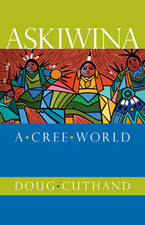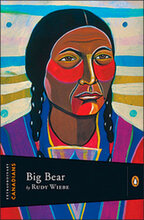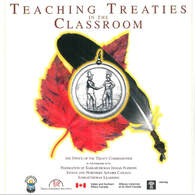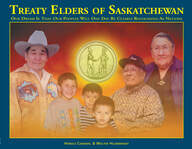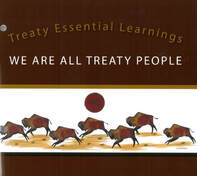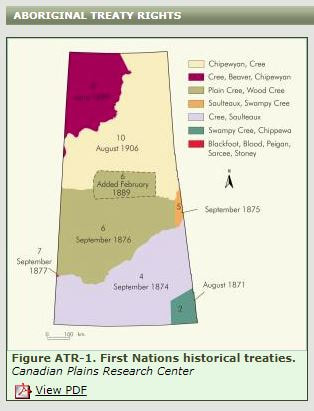Grade 8
Treaty Promises and Provisions
Books
Askiwina: A Cree WordIn Askiwina: A Cree World, D Cuthand offers fresh insights and straight talk over platitudes and dogma, providing readers with a bridge to understanding Aboriginal philosophy, history, culture, and society. He explores the basics of Aboriginal spirituality - the four directions, the trickster Wesakechak, creation stories, coming-of-age rituals, the Sundance, and sacred places on the prairies. He describes Saskatchewan history from an Aboriginal point of view, a perspective from which familiar events like the Battle of Cutknife Hill, the siege of Battleford, and the establishment of Prince Albert look profoundly different.(Publisher)
|
Cuthand, D. (2007). Askiwina: A Cree Word. Regina, SK: Croteau Books.
Extraordinary Canadians: Big BearBig Bear (1825–1888) was a Plains Cree chief in Saskatchewan at a time when aboriginals were confronted with the disappearance of the buffalo and waves of European settlers that seemed destined to destroy the Indian way of life. In 1876 he refused to sign Treaty No. 6, until 1882, when his people were starving. Big Bear advocated negotiation over violence, but when the federal government refused to negotiate with aboriginal leaders, some of his followers killed 9 people at Frog Lake in 1885. Big Bear himself was arrested and imprisoned. Rudy Wiebe, author of a Governor General’s Award–winning novel about Big Bear, revisits the life of the eloquent statesman, one of Canada's most important aboriginal leaders. (Publisher)
|
Wiebe, R. (2008). Extraordinary Canadians: Big Bear. Toronto, ON: Penguin Random House Canada.
Price, R. (1991). Legacy: Indian Treaty Relationships. Edmonton, AB: Plains Publishing.
Office of the Treaty Commissioner (2002). Teaching Treaties in the Classroom Grades 7-12. Saskatoon, SK: Office of the Treaty Commissioner.
Treaty Elders of Saskatchewan: Our Dream is that Our People Will One Day Be Recognized as NationsTreaty Elders of Saskatchewan brings together the voices many Saskatchewan elders to provide a truly Indigenous perspective on treaties and treaty rights. The result of a number of Treaty Elders forums, this is a readable and highly informative book that places the voices of Indigenous Elders first. The comments recorded here provide a wealth of context and understanding for wide-ranging topics ranging from conceptions of the land, living together, scared promises to one another, and evolving interpretations of Treaty Rights. (Publisher)
|
Cardinal, H. & Hildebrandt, W. (2000). Treaty Elders of Saskatchewan: Our Dream is That Our People Will One Day Be Recognized as Nations. Calgary, AB: University of Calgary Press
Treaty Essential Learnings: We Are All Treaty PeopleThe Treaty Essential Learnings document is a reference guide to understanding the foundational aspects of the “Teaching Treaties in the Classroom” program. The Treaty Essential Learnings are those topics, concepts and understandings of treaties and the treaty relationship that students should be expected to know by the end of Grade 12.
|
Office of the Treaty Commissioner (2008). Treaty Essential Learnings: We Are All Treaty People. Saskatoon, SK: Office of the Treaty Commissioner.
Videos
8th Fire Dispatch: Sacred Heart Residential School - Part 1
|
|
CBC North's Paul Andrew's piece on the legacy of one of the oldest and most notorious residential schools in the country - Part 1.
|
CBC. 8th Fire Dispatch: Sacred Heart Residential School - Part 1. Retrieved from https://www.cbc.ca/player/play/2183547330
CBC. 8th Fire Wab Kinew 500 Years in 2 Minutes. Retrieved from https://www.youtube.com/watch?v=L7LY-fXzhZI
|
|
Big Bear.
Plains Cree leader Big Bear (Mistahimaskwa) was famous for being the first major prairie chief to refuse to sign a treaty. He was an avid counsellor for peaceful dealings with the Canadian government, but that trait eventually caused some of his followers to refuse his leadership.
Award-winning author and professor Rudy Wiebe has written on Big Bear. His 1973 novel “The Temptations of Big Bear” earned him a Governor General’s Award. |
CPAC. Extraordinary Canadians: Big Bear. Retrieved from https://www.cpac.ca/en/programs/extraordinary-canadians/episodes/49649316/#
|
|
Rudy Wiebe on Big Bear: A Clip on Extraordinary Canadians
Rudy Wiebe tells the story of one of the greatest First Nations leaders Canada has ever known. Non-violent, a believer in discussion and diplomacy, Big Bear is the earliest forerunner of the traits Canadians today pride themselves on. Directed by Kenneth Hirsch. Produced by PMA Productions Inc.
|
PMA Prroductions Inc. Rudy Wiebe on Big Bear: A Clip on Extraordinary Canadians. Retrieved (Feb 2020) from https://www.youtube.com/watch?v=XEpiafTE9GU
|
|
A report by Coleen Rajotte about a remote Ojibwa community in northwestern Ontario where living conditions are desperate and the rates of suicide among youth are some of the highest in the world. Part of the CBC documentary series 8th Fire. 10:48
|
CBC (2011). Tragedy of Pikangikum with Coleen Rajotte. Retrieved (Feb 2020) from https://www.cbc.ca/news/tragedy-of-pikangikum-with-coleen-rajotte-1.1709943
Web Posts
Aboriginal Treaty Rights.
The Encyclopedia of Saskatchewan. Aboriginal Treaty Rights. Retrieved (Feb 2020) from https://esask.uregina.ca/entry/aboriginal_treaty_rights.jsp
|
An overview of the impact of European Diseases to Aboriginal Health.
|
American Indian and European Diseases. Retrieved (Feb 2010) from http://nativeamericannetroots.net/diary/325
|
By 1870 Canada was made up of four provinces: Ontario, Quebec, Nova Scotia, and New Brunswick. Prime Minister John A. Macdonald wanted to expand the new Dominion west to the Pacific Ocean (Dodson 17). ... John A. Macdonald envisioned the west as a grain producing region full of European immigrants (Dodson 17). In achieving this, the government had to get permission from the First Nations in the area to surrender their lands and in doing so had to negotiate a Treaty with them. Treaties were signed with First Nations in Canada between 1871 and 1921.
|
The Story of Treaty Six. Retrieved (Feb 2020) from https://treaty6education.lskysd.ca/storyoftreaty6.html

